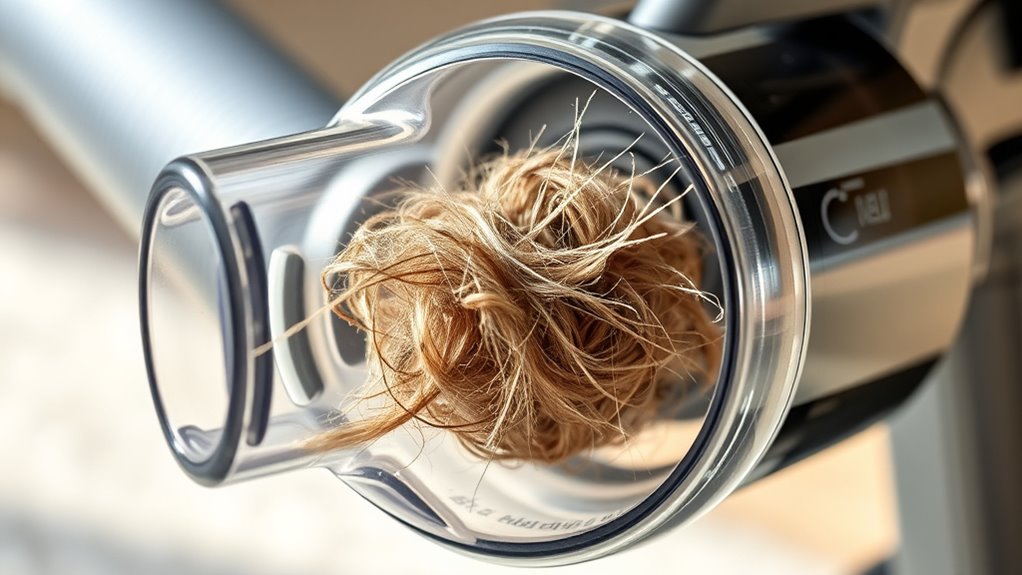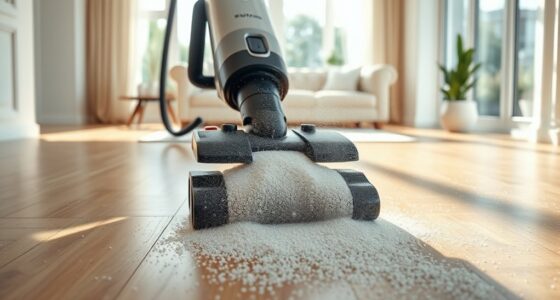If your vacuum’s suction suddenly drops or it’s not cleaning as well, you likely have a clog or airflow restriction. Signs include reduced power, dirt and debris being left behind, or needing to go over the same area multiple times. Check filters, empty dustbins, and inspect hoses and brush rolls for blockages. If these issues sound familiar, continue exploring how to identify and fix airflow restrictions to restore your vacuum’s performance.
Key Takeaways
- Notice a significant drop in suction power or vacuum struggles to pick up debris.
- Floors appear less clean after vacuuming, requiring multiple passes.
- The vacuum’s airflow sounds weaker or there’s unusual noise during operation.
- Check for visible blockages or debris buildup in hoses, wand, or brush roll.
- The dustbin or bag is full, or filters are dirty, restricting airflow and reducing suction.

Have you noticed your vacuum isn’t cleaning as effectively as it used to? If so, it’s likely a sign that something’s blocking airflow or causing a reduction in suction. Airflow restrictions are a common culprit, often resulting from clogged hoses, full dustbins, or dirty filters. When airflow is hindered, your vacuum can’t generate the suction needed to pick up dirt and debris properly. This means your floors won’t look as clean, and you might find yourself going over the same area multiple times without much improvement.
If your vacuum isn’t cleaning well, airflow blockages from clogged filters or hoses could be the cause.
One of the first things to check is the vacuum’s filter. Over time, filters trap dust, hair, and other particles, but they can become clogged or dirty, especially if you haven’t replaced or cleaned them recently. A dirty filter restricts airflow, which directly impacts suction power. If you notice a decrease in cleaning performance, inspect the filter. If it’s visibly dirty, it’s time to clean or replace it. Many vacuum models have washable filters—simply rinse them with water and let them dry completely before reinstalling. For non-washable filters, follow the manufacturer’s recommendations for replacement. Neglecting filter maintenance is a quick way to reduce suction and strain your vacuum’s motor.
Another common cause of airflow restrictions is a blocked hose or wand. Regularly inspect these components for obstructions, such as tangled hair or debris lodged inside. Detach the hose if necessary and run a broomstick or similar object through it to dislodge anything stuck inside. Sometimes, a simple clear-out restores proper airflow and suction. Also, check the brush roll area; hair and fibers can wrap around the brush and impede movement, creating additional resistance and reducing overall suction.
The dustbin or bag is another critical area to examine. When it’s full, airflow is severely restricted, leading to diminished suction. Empty the dustbin or replace the bag if it’s full, ensuring that the seal is tight so no air leaks. Do not forget to check for any small blockages or debris that might have accumulated in the trap or around the inlet. Additionally, understanding the importance of filtration technology can help you select models that maintain consistent suction and air quality over time.
Frequently Asked Questions
Can a Clogged Vacuum Damage the Motor?
A clogged vacuum can indeed damage the motor if you don’t address it promptly. When airflow is blocked, the vacuum motor works harder, which can cause overheating and wear out the motor faster. To prevent this, regularly check for clogs and perform clog prevention measures. Keeping your vacuum free of obstructions guarantees the motor runs smoothly and lasts longer, saving you from costly repairs down the line.
How Often Should I Check for Clogs?
You should check for clogs every few weeks to keep your vacuum running smoothly. Don’t wait until you notice reduced suction or performance issues. Regular maintenance tips, like inspecting the hose and filters, help prevent bigger problems. Use troubleshooting techniques such as disconnecting parts and clearing blockages promptly. Staying proactive guarantees your vacuum stays effective, extends its lifespan, and avoids motor damage caused by unnoticed clogs.
Does a Full Bag Cause Reduced Suction?
Yes, a full bag can cause decreased suction in your vacuum. When the bag is full, it blocks airflow, making it harder for the vacuum to pick up debris effectively. You’ll notice less power and your vacuum struggling to clean properly. To restore peak suction, check the bag regularly and replace it when it’s full. Keeping the bag from overfilling ensures your vacuum operates efficiently and maintains strong suction.
Can Pet Hair Clog My Vacuum?
Imagine vacuuming your living room and noticing it’s losing power. Pet hair buildup is a common culprit, causing airflow obstruction. Yes, pet hair can clog your vacuum, especially around the brush roll or hose. It traps debris, reducing suction. To fix this, regularly check and clear any pet hair buildup from these areas. Keeping your vacuum clean guarantees it maintains ideal airflow and suction power.
What’s the Best Way to Prevent Clogs?
To prevent clogs, regularly maintain your vacuum’s filter and inspect the hose for blockages. Clean or replace filters as recommended by the manufacturer, and check the hose for tangled hair, debris, or pet hair that might cause obstructions. Avoid overloading your vacuum with large debris and clear clogs promptly. Routine maintenance keeps airflow smooth, ensuring your vacuum performs efficiently and reduces the risk of clogs or reduced suction.
Conclusion
So, if your vacuum suddenly can’t even pick up a crumb, it’s like trying to suck up a mountain with a tiny straw—you’re not going anywhere fast. Don’t ignore those warning signs; your vacuum’s telling you it’s fighting a battle it can’t win alone. Fix that clog, clear the blockage, or give it some love before it turns into a dust monster that takes over your whole house. Trust me, your floors will thank you!








